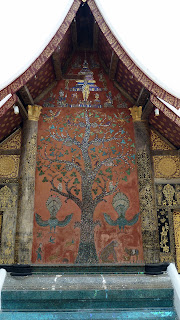Luang Prabang was just a wonderful place to be and to relax after the relative bustle of Vientiane. Neither of us really feel like city lovers although we have enjoyed all the ones visited on this trip. LP is very much a tourism town although still retaining its charming and gentle manner, reinforced by an 10.30p.m. curfew on bars etc..
We flew up from Vientiane with Joe and Pip who were to stay a couple of days before returning to Thailand. We had booked ourselves into a charming guesthouse with our room opening into the garden where we took breakfast each day.
The room came with complimentary bicycles, which were to prove extremely useful during our time in this delightful little town which seemed to be packed with Temples, Wats and markets.
 |
Before a sale
|
 |
| After we bought something |
Our guesthouse was adjacent to a temple and the monks were to wake us by beating drums for five minutes at 5.00am on our first morning there: it marked the beginning of a two day festival (yes, it was to happen again the next day), which also included their melodious chanting at 5.00pm on both evenings. The monks only eat twice a day and their second and last meal must be eaten before 11.00am in the morning, after which, they may not eat again until the next day. To make matters even more taxing for them, they have to go out each morning to the people in the town with a covered bowl and ask for their food for that day. Well it is one way of using up the leftovers; although one would need quite a lot to feed some 200 monks every day. Many of them are quite young lads and it was refreshing to see them using up some laddish energy on the odd occasion.
 |
| Young monks playing in the river |
The temples in the town were really quite stunning architecturally.
 |
| Temple at Wat Xieng Thong |
 |
Mosaic of Tree of Life at Wat
Xieng Thong |
The town exhibits a great deal of old colonial French architecture in its shops, cafes and schools.














